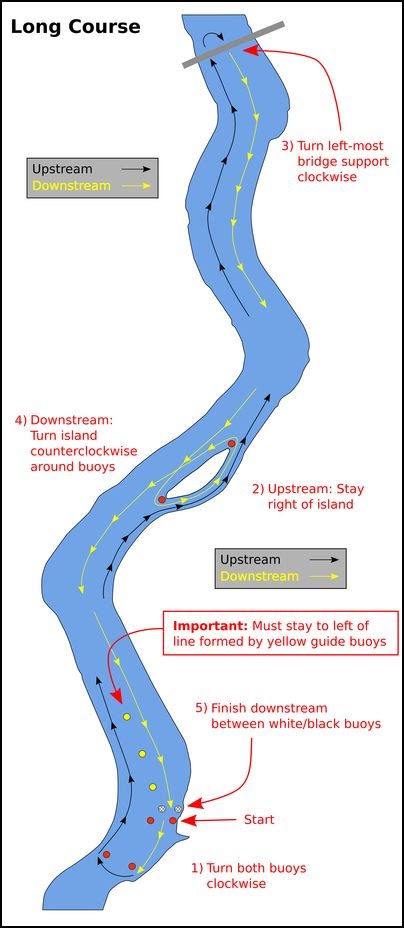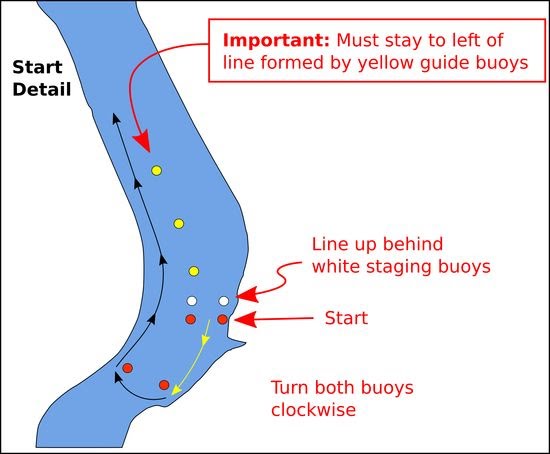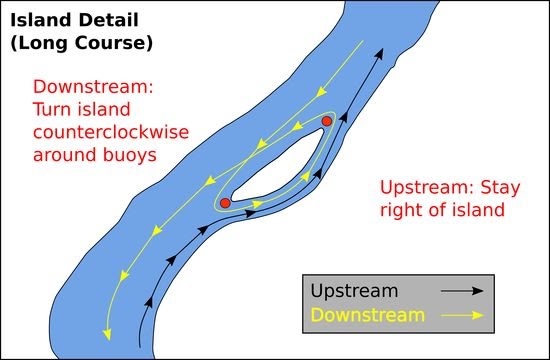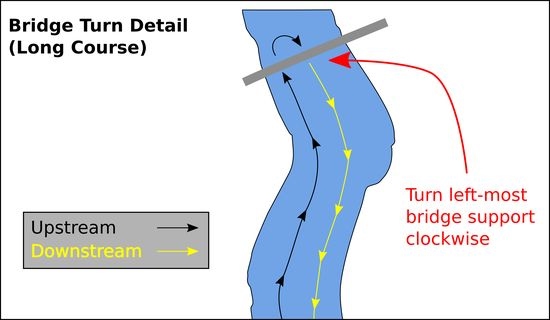Today was the Long Lake Long Boat Regatta, or LLLBR for short. LLLBR and me go way back – back in 2008 Dan Murn convinced me and some other of the novice Rochester racers to come, and he convinced the organizer, Brian Mac, to put on a short race for our benefit. First and probably last time I beat Tom Murn in a race.
I don’t know how they do it, but somehow they usually have awesome weather for this race. Yeah, we’ve had some windy ones, but I don’t think we’ve had bad rain or thunderstorms. (Sorry, I probably just jinxed it for next year, haven’t I?) And the leaves are turning and it is just beautiful up here. This morning it was quite cool, almost cold, and as usual I didn’t know what to wear. I showed up with my v-cold long sleeve shirt and v-cold paddling pants. As I prepared the boat it warmed up a tiny bit and first I switched the long sleeve v-cold top for a short sleeve v-cold top (in retrospect, a good move) and then later just before getting in the boat I stripped off my paddling pants exposing my v-heat shorts (in retrospect, not such a good move). You see, a few years ago Jim told me I should be a little bit chilly when paddling into the wind so I don’t overheat when I turn back downwind. Which is great in practice, but I swear we never had anything but headwinds or beam winds for the entire race. Got some following waves, but never actually got a respite from the wind in my face and blowing cold spray onto my legs.
I put my Muvi camera on the front of the boat, since when I’d tried it as a head mount last weekend it had given me a wicked headache plus I hadn’t started it. The FAQ for this camera notes that people had have problems with the waterproof case fogging up, and they provide a bunch of silica gel packets for include in the case to help prevent that. I decided to be safe and put two fresh packets (right out of the foil sealed packets) today, but it didn’t work. As I approached the starting line, I could see the damn thing fogging up, and it never cleared. I’m cursed by movie cameras that hate me. If it wasn’t for all the great feedback I get from my loyal followers I’d give up. (If anybody wants to start a fund to buy me a GoPro Session 5 or two, I’m sure I’d produce much better videos without so many technical issues, hint, hint.) The Countour Roam camera on the back continues to have great battery life, be simple to operate, the only problem is it doesn’t do 1080p at 60fps and I don’t think the video is smooth at 30fps.
Oh, and because all racers like to start their excuse making early, I should mention that I’ve been dealing with terrible allergy symptoms for a couple of weeks. Sneezing, stuffy nose, and a slightly sore throat. Yuck. The only factor I felt like was still in my favor was that although my nose was stuffed, it didn’t seem to be interfering with taking deep breaths through my mouth. So I figured I might be ok, or I might have a terrible coughing fit somewhere out on the course and have to DNF. I was giving even odds, but nobody would take the bet.
So at the start, there were some surprises. Todd and John Hair didn’t show up. Jim was paddling in touring class in a v8 for the challenge. Matt was in a double with some guy who hasn’t been paddling in a Surfski much but who evidently in his first outing last week did the third day of the 90 Miler – so maybe not much time in kayaks, but a way above average paddler. There were only three of us in unlimited class, me, Mike and a guy in a V10 GT who looked like the sort of guy who deserved to be in a GT class boat. I knew if my breathing didn’t fail, I could probably beat Mike, and obviously the GT guy was going to beat us. So really my race was against my own lungs, and if they were good, my goal was to beat Roger. Roger had beaten me in our last showdown in the Adirondaks by riding my stern wake the whole way and then coming around me just as I picked up a weed on my bow. I didn’t want to let that happen again. Actually, I was sort of hoping that I’d beat Mike, but it would be really close. Mike is coming back from injury and down time and he’s getting faster, and I want us to be head to head rivals again.
At the start, Jim was off like a rocket, followed closely by the GT guy. There were a couple a c-4s and a guy in a 18x touring class boat. Suddenly Matt’s double came roaring up the outside and quickly joined Jim. It looked like they dropped GT guy pretty handily. I was on the side wake of one of the c-4s and another c-4 was well off to my right. The guy in the 18x had a gap on me, and I tried a couple of times to close it but he was holding me off. I found out later his name is Eric (I think) so I’m going to refer to him as Eric for the rest of this blog. In a quick glance back, it looked like Mike was on the stern wake of the same c-4 I was on, and I couldn’t see Roger which was a bit surprising. The other c-4 looked like it was actually a tiny bit faster than the one I was on, so I accelerated a bit and left the first behind with the thought of maybe glomming onto the faster ones wake.
But then I hear this horrible wheezing sound and realize Roger has managed to catch up to me, and now he’s got designs on catching Eric. He and Eric were in the same type of boat, and I believe they both live in the Adirondacks, so I bet there is some sort of rivalry going on there. Fine by me. As Roger went wheezing by, I jumped on his stern wake and graciously allowed him to tow me up to Eric. I wasn’t exactly getting a free ride here – even with the wake, my heart rate was still up over 160, in the “red zone”. But so far my lungs were holding on. We got into a nice conga line, but then we hit some wakes from war canoes in the other direction and some other waves and then the faster c-4 actually barged into the line and forced me off Roger’s wake and suddenly they’ve got three boat lengths on me. Oh oh. I tried to take it in good humor, saying to the c-4 guys “hey, I’m paddlin’ here” like in Midnight Cowboy.
At the turn I turned a bit tighter than them and managed to recover one of those boat lengths, and so I put in a massive effort to close the gap up and get on Roger’s stern wake again. We had a fairly good gap over the c-4s, and Mike was still hanging onto the stern wake of one of them.
I thought after the turn we’d be heading down wind since we’d been going up wind before the turn, but somehow that didn’t work out that way. If anything the headwind was stronger going this way. Eric is a powerful guy and every time the wind picked up, he seemed to put the hammer down – I’m pretty sure it was a deliberate attempt to gap us. We stayed mostly together back under the bridge, and then we hit some waves and we broke up again. I put in a supreme effort to get back on Roger’s stern wake again, but he wasn’t closing on Eric. So I stepped up my game and came around Roger and blasted my way up to Eric’s stern. I realized I was probably towing Roger back to his rival, but that’s not my problem.
But then we hit some more waves and wind and I started coughing up phlegm. The allergy symptoms had finally started affecting my race. Suddenly I lost Eric’s wake again. But it looked like I’d managed to gap Roger as well. Ok, now it’s a matter of just trying to maintain my pace and not blow up, and maybe I could get back to Eric after the turn when we’re not fighting our way into the wind. Yeah, I’m an optimist.
There was confusion in my mind about the second turn. The way Brian had described it in the pre-race meeting had left it ambiguous in my mind as to whether we were supposed to go around the island, or just the boat parked in front of the island. Jim and Matt and GT guy and the war canoes had all been so far ahead I couldn’t really tell whether they’d rounded the island or not, but GT guy’s line really looked like he’d circled the island. So I was lined with the shore line ready to go around, and so was Eric, but he actually yelled something to the people on the boat, stopped paddling to listen to their response, and then abruptly turned directly towards them. Ok, I guess we’re not going around the island. Probably just as well, because as it was it looked like the race was going to be longer than advertised. We were expecting a 16 km (10 mile) race, but if my calculations were correct, it was going to be more like 17.5 km.
After the turn, the expected tail wind didn’t happen. It felt like it was a direct beam wind most of the time, with occasional blasts from in front just to make this hard. The waves were from behind but they weren’t giving me any push. My coughing got worse, and Eric continued to pull away. But the two c-4s from earlier came through. Unfortunately Mike wasn’t on their stern wakes any more, but fortunately neither was Roger. Once again, the one I’d been on the side wake of near the beginning came by close enough that I could get on the side wake again, while the other one was a bit ahead but way off to the right side.
The stern paddler on “my” c-4 was nice – she offered me words of encouragement as well as to her own team. The stern in the other c-4 just seemed to be yelling at his paddlers for not working hard enough. I didn’t last long on the side wake, but dropped into her stern wake and got a really nice ride. My heart rate climbed back into the red zone again because it was hard work, but that little bit of help from their stern wake was all it took to get me seeing speeds up near 11 km/hr again. They were slowly and surely catching the other c-4 and it looked like they were bringing me up closer to Eric. I had a little discussion with myself and said that if we did catch Eric, I would not pass him because it would be unfair to beat him using a canoe wake, but I’d be quite happy to glom on to his wake again and finish at the same time as him. As it happened, we didn’t end up catching Eric, so it was a moot point. I was also trying to gasp out some words of encouragement for my tow truck, but I don’t know if they heard me because I was also coughing a fair bit.
So in the end, Jim won touring class, surprising nobody. GT guy won unlimited, surprising nobody. The c-4 that was towing me beat the guys who’d cut me off way back near the beginning. Eric was powerful and strong and beat me and Roger, coming second in touring class. I’d accomplished everything I’d hoped for at the beginning of the race, beating Roger, beating Mike, and beating seasonal allergies. I’ve got a bit of soreness in the old bronchial tubes as a result, but I also had a great day on a beautiful lake in the sunshine and got to hang out with friends afterwards.
Jim said before race that we should dedicate this day to the memory of Bill Feeney. I think we did him proud.





